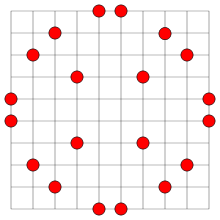- No-three-in-line problem
-
In mathematics, in the area of discrete geometry, the no-three-in-line-problem, introduced by Henry Dudeney in 1917, asks for the maximum number of points that can be placed in the n × n grid so that no three points are collinear. This number is at most 2n, since if 2n + 1 points are placed in the grid some row will contain three points.
Contents
Lower bounds
Paul Erdős (in Roth, 1951) observed that, when n is a prime number, the set of n grid points (i, i2 mod n), for 0 ≤ i < n, contains no three collinear points. When n is not prime, one can perform this construction for a p × p grid contained in the n × n grid, where p is the largest prime that is at most n. As a consequence, for any ε and any sufficiently large n, one can place
- (1 − ε)n
points in the n × n grid with no three points collinear.
Erdős' bound has been improved subsequently: Hall et al. (1975) show that, when n/2 is prime, one can obtain a solution with 3(n - 2)/2 points by placing points on the hyperbola xy ≡ k (mod n/2) for a suitable k. Again, for arbitrary n one can perform this construction for a prime near n/2 to obtain a solution with
- (3/2 − ε)n
points.
Conjectured upper bounds
Guy and Kelly (1968) conjectured that one cannot do better, for large n, than cn with
As recently as March, 2004, Gabor Ellmann notes an error in the original paper of Guy and Kelly's heuristic reasoning, which if corrected, results in
Applications
The Heilbronn triangle problem asks for the placement of n points in a unit square that maximizes the area of the smallest triangle formed by three of the points. By applying Erdős' construction of a set of grid points with no three collinear points, one can find a placement in which the smallest triangle has area
Generalizations
A noncollinear placement of n points can also be interpreted as a graph drawing of the complete graph in such a way that, although edges cross, no edge passes through a vertex. Erdős' construction above can be generalized to show that every n-vertex k-colorable graph has such a drawing in a O(n) x O(k) grid (Wood 2005).
Non-collinear sets of points in the three-dimensional grid were considered by Pór and Wood (2007). They proved that the maximum number of points in the n x n x n grid with no three points collinear is Θ(n2). Similarly to Erdős's 2D construction, this can be accomplished by using points (x, y, x2+y2) mod p, where p is a prime congruent to 3 mod 4. One can also consider graph drawings in the three-dimensional grid. Here the non-collinearity condition means that a vertex should not lie on a non-adjacent edge, but it is normal to work with the stronger requirement that no two edges cross (Pach et al. 1998; Dujmović et al. 2005; Di Giacomo 2005).
Small values of n
For n ≤ 40, it is known that 2n points may be placed with no three in a line. The numbers of solutions (not counting reflections and rotations as distinct) for small n = 2, 3, ..., are
References
- Dudeney, Henry (1917). Amusements in Mathematics. Edinburgh: Nelson.
- Emilio Di Giacomo, Giuseppe Liotta, and Henk Meijer (2005). "Computing Straight-line 3D Grid Drawings of Graphs in Linear Volume". Computational Geometry: Theory and Applications 32 (1): 26–58. doi:10.1016/j.comgeo.2004.11.003.
- Vida Dujmović, Pat Morin, and David R. Wood (2005). "Layout of Graphs with Bounded Tree-Width". SIAM Journal on Computing 34 (3): 553–579. doi:10.1137/S0097539702416141.
- Stefan Felsner, Giuseppe Liotta, and Stephen K. Wismath (2003). "Straight-Line Drawings on Restricted Integer Grids in Two and Three Dimensions". Journal of Graph Algorithms and Applications 7 (4): 363–398. http://jgaa.info/accepted/2003/Felsner+2003.7.4.pdf.
- Flammenkamp, Achim (1992). "Progress in the no-three-in-line problem". Journal of Combinatorial Theory. Series A 60 (2): 305–311. doi:10.1016/0097-3165(92)90012-J.
- Flammenkamp, Achim (1998). "Progress in the no-three-in-line problem, II". Journal of Combinatorial Theory. Series A 81 (1): 108–113. doi:10.1006/jcta.1997.2829.
- Guy, R. K.; Kelly, P. A. (1968). "The no-three-in-line problem". Canadian Mathematical Bulletin 11 (0): 527–531. doi:10.4153/CMB-1968-062-3. MR0238765.
- Hall, R. R.; Jackson, T. H.; Sudbery, A.; Wild, K. (1975). "Some advances in the no-three-in-line problem". Journal of Combinatorial Theory. Series A 18 (3): 336–341. doi:10.1016/0097-3165(75)90043-6.
- Lefmann, Hanno (2008). "No l Grid-Points in spaces of small dimension". Algorithmic Aspects in Information and Management, 4th International Conference, AAIM 2008, Shanghai, China, June 23-25, 2008, Proceedings. Lecture Notes in Computer Science. 5034. Springer-Verlag. pp. 259–270. doi:10.1007/978-3-540-68880-8_25.
- Pach, János; Thiele, Torsten; Tóth, Géza (1998). "Three-dimensional grid drawings of graphs". Graph Drawing, 5th Int. Symp., GD '97. Lecture Notes in Computer Science. 1353. Springer-Verlag. pp. 47–51. doi:10.1007/3-540-63938-1_49.
- Attila Pór and David R. Wood (2007). "No-three-in-line-in-3D". Algorithmica 47 (4): 481. doi:10.1007/s00453-006-0158-9.
- Roth, K. F. (1951). "On a problem of Heilbronn". Journal of the London Mathematical Society 26 (3): 198–204. doi:10.1112/jlms/s1-26.3.198.
- David R. Wood (2005). "Grid drawings of k-colourable graphs". Computational Geometry: Theory and Applications 30 (1): 25–28. doi:10.1016/j.comgeo.2004.06.001.
External links
- Flammenkamp, Achim. "The No-Three-in-Line Problem". http://wwwhomes.uni-bielefeld.de/achim/no3in/readme.html.
Categories:- Combinatorics
- Lattice points
- Conjectures
- Mathematical problems
Wikimedia Foundation. 2010.


![c = \sqrt[3]{\frac{2\pi^2}{3}} \approx 1.874.](e/5bed35f95a0f0024a523fdf8a325fe9e.png)

